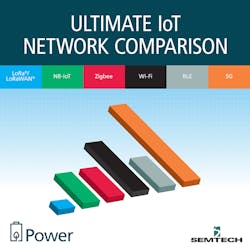LPWAN for All: What’s the Future of Low-Power, Long-Range Connectivity?
What you’ll learn:
- How open standard networks are the key to supporting massive IoT.
- Predictions for LPWAN’s use in the future.
- How widespread IoT infrastructure will be built by layering networks like 5G, Wi-Fi, and LoRa.
As 5G connectivity and infrastructure continues to grow, the industry has wondered: Where does this leave low-power wide-area networks, or LPWAN? Will widespread high-bandwidth connectivity render it obsolete?
Here’s a spoiler: There’s no single network that will render all others obsolete. Let’s explore why that is, and how the future of the Internet of Things (IoT) will be built through open networks and collaboration.
Reliable Long-Range Coverage
Let’s start with establishing the benefits of LPWAN and why it’s been successful in the first place. The key benefit is in the name: low-power, wide-area network. By nature, LPWAN technology has the ability to transmit information across long distances without using much power. This is especially beneficial for IoT applications, which require small packets of information to be communicated regularly, often in situations that aren’t accessible to other networks.
For example, LPWAN is a great option for monitoring operations remotely, whether that’s in the middle of the ocean or in a rural agriculture setting. Small amounts of information like machinery status, output, and environmental monitoring can be shared regularly, alerting of any activity out of the norm before there’s an issue. In many remote settings, other networks can’t offer the same consistent, cost-effective, and reliable coverage.
Industry Growth
There’s also growth in the industry. LoRaWAN, one of the most widespread LPWAN protocols, has a very strong ecosystem and plenty of deployed use cases. It’s managed by the nonprofit LoRa Alliance organization. At the time of this article, there are 163 private and public LoRaWAN network operators, a number that continues to climb.
Because it’s an open protocol, LoRaWAN gives customers the flexibility they need to develop their IoT applications. In addition, LoRaWAN is a proven standard that’s endorsed by the International Telecommunication Union (ITU) and backed by a strong, global ecosystem from chip-to-cloud companies like AWS, Microsoft, Orange, and Semtech.
Devices are ramping up as well: ABI Research predicts that by 2026, 50% of non-cellular LPWA will feature Semtech’s LoRa devices. And Juniper Research reports that the overall cellular IoT market (including narrowband IoT and LTE-M) will grow by 95% between 2022 to 2026.
Interoperability and the Competition
Often the “LPWAN is dead” argument is based in a desire for a complex, low-latency network that can handle massive amounts of data. It’s true—LPWAN can’t transmit the same amount of data as a network like 5G.
That said, networks aren’t competitive, they’re complementary. In many IoT use cases, 5G would be the equivalent of using a sledgehammer to crack a nut—an excessive amount of power used where a right-sized technology would be a better fit. As the IoT grows, the capabilities of each network will layer over the next to support the billions of messages regularly transmitting across the IoT.
Take, for example, how LPWAN and Bluetooth Low Energy (BLE) can work together. BLE’s versatility and ubiquity makes it a go-to choice for short-range communications like mobile payments or consumer IoT. However, it’s limited in how far it can transmit data, which just happens to be where LPWAN’s strength lies. By pairing the two technologies, LPWAN extends BLE’s capabilities and makes deployments more flexible.
That’s why interoperability is key for IoT. Everything needs to talk to one another for its true purpose to be fulfilled. As 5G targets low-latency and high-throughput applications, the applications using LoRa and LoRaWAN will make up a larger portion of the massive IoT space, led by mobile operators, unlicensed spectrum operators, and enterprises across private rollouts.
Final Thoughts
The market is heading toward a multi-radio access network (or Multi-RAN) strategy where each network is complementary rather than competitive. So is there an end in sight for LPWAN? No. As the world of IoT continues to grow with new applications every day, the need for a low-power, long-range network grows as well.
Semtech, the Semtech logo and LoRa are registered trademarks or service marks of Semtech Corporation or its affiliates.
About the Author
Marc Pégulu
Vice President, IoT Strategy and Products, Semtech
Marc Pégulu has been vice president of IoT in the wireless and sensing products group at Semtech since June 2015. He held the position of vice president of wireless and sensing products from June 2014. Prior to this appointment, he held the position of director of marketing and applications. Pégulu joined the Company in March 2006 and was involved in several key technology initiatives, including LoRa wireless and software-defined modem technologies. Prior to joining Semtech, he held positions in chips and systems development at Thomson CSF, Thales, Atmel, and DibCom in France and China.
Pégulu holds a Master of Science degree in electronics and telecommunications from Institut National Polytechnique of Grenoble, France, and is a graduate of the Executive MBA program of ESCP Europe.


